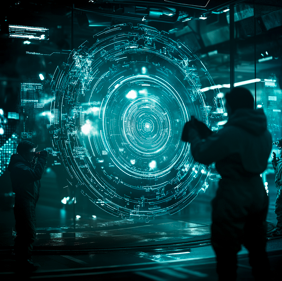· Yvette Schmitter · Technology · 5 min read
The New ROI - From Return on Individual to Return on Innovation, Three Ascents of AI-levation
In 2024, every 2.5 days a frontier model was released. This can feel overwhelming...

In 2024, every 2.5 days a frontier model was released. This can feel overwhelming for some or paralyzing to others as this pace doesn’t align with a reasonable pace for organizations to scale and get employees trained, let alone embrace it. AI-forward organizations want to be emergent but are well aware that AI is adoption is not cheap, and they want to avoid waste. This fuels the rapidly evolving landscape of generative AI adoption and AI-forward leaders are quickly discovering that the path to transformation isn’t a single leap to ROI but more of a natural progression from crawl to soar. As the release of The World Economic Forum’s 2025 Job Report earlier this month reported, 86% of respondents to their survey expect artificial intelligence (AI) and information processing to transform their business by 2030 (Page 11 of 290). What does this mean for jobs? Well, over the next 5 years, it’s projected that 170 million new jobs will be created, and 92 million jobs will be displaced but that amounts to a net employment INCREASE of 7% or 78 million jobs. This is the cycle of innovation. I’ve said this from the very beginning, AI will not take your job but the person who knows how to use it will. So, it’s imperative that everyone skills up on AI not just to be curious but to future proof your career.
The Trinity
There’s a very compelling trinity in AI’s business value creation: Foundation, Acceleration, and Innovation – each representing a distinct juncture in the AI journey from employee productivity to tangible operational efficiency to market revolution.
At the ground level, “Foundation” represents the essential first steps in AI adoption and it’s completely understandable to feel overwhelmed in this relentless marathon of modern innovation, because trying to keep up with the latest technology feels like chasing a runaway treadmill that’s perpetually set to “faster than light” mode. Just as you grasp the latest gadget, it’s already outdated by the time you untangle the charging cable. But it’s imperative to start somewhere and do something.
AI adoption and implementation is a marathon not a sprint and it’s just as time consuming and costly. So, first, don’t worry about having the latest new “thing.” Pick one platform, maximize the value and personalize the use cases on that platform. Then, select 1-3 use cases your employees can use every day that increase productivity and elevate the quality of their work experience. Like learning to crawl before walking, maximize implementations focusing on augmenting individual employee productivity with an investment that can start as low as around $500 per employee. While modest in scope, these baseline enhancements – empowering knowledge and productivity of employees (non-technical) and developers (technical) with AI tools – build the digital dexterity necessary for larger transformations. The right AI tool can turn your developers into superpowered developers who will be able to derive more value from these tools. And for your non-technical employees, there’s a clear direction being made to make the language of code the human language, so now the average person will be able to do what ”coders” use to do. But pick ONE because if you’re building on today’s tech and maximizing the value so when some “new” model is introduced it doesn’t change your adoption, but it will up level it. For employees, this is important because 59% of you will require upskilling by 2030. So, this is more than wanting to remain competitive, the future of work is going to change because of rapid technological advancement. This will bring about massive change and impact and over the next five years we will witness extraordinary change.
As organizations find their footing, they can begin to “accelerate” their strides. This middle ground can yield nominal returns anywhere between $250K and $5M. However, these returns are based on the organization determining which use case will enable the outcomes to deliver the ROI expected. This is the speed walking/run phase where businesses learn to run with AI, digitally transforming both existing processes, employees as well as team dynamics. For example, think of customer service and reimagined claims processing processes are two good illustrations of this stage, where traditional operations evolve into streamlined, AI-enhanced powerhouses.
Now, organizations can master the art of “innovation” – taking flight into entirely new business models with returns soaring anywhere from $20M and beyond. Organizations, now enabled with power to break through conventional limits, these initiatives – anything from revolutionary drug discovery platforms to AI-driven investment funds to robotics – represent some the of the ultimate expressions of AI-enabled transformation by completely redefining market boundaries.
AI-forward leaders today must challenge the notion of there being a single business case for artificial intelligence. Instead, those on the AI journey need to recognize there are actually 3 business cases. A journey return on employee (AI to increase productivity), return on investment (transformed processes that enable business value), and return on future (AI leader, disrupter) all contribute to a natural evolution of increased revenue generation. Each one builds on the last, forming a transformational ladder that enterprises can climb at their own pace. The implications are clear: success in the AI era requires intentional, outcome-specific progression through each stage rather than a single big jump. Businesses must understand where they are on this path and plan their strategy accordingly, whether it is improving their operational basis, accelerating their business transformation, or preparing for market-defining innovation. Understanding and conquering each stage of the journey could make the difference between leading the future and being surpassed.


